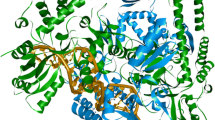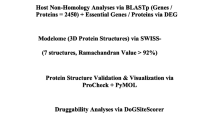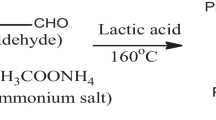Abstract
There is emergence of multidrug-resistant Salmonella enterica serotype typhi in pandemic proportions throughout the world, and therefore, there is a necessity to speed up the discovery of novel molecules having different modes of action and also less influenced by the resistance formation that would be used as drug for the treatment of salmonellosis particularly typhoid fever. The PhoP regulon is well studied and has now been shown to be a critical regulator of number of gene expressions which are required for intracellular survival of S. enterica and pathophysiology of disease like typhoid. The evident roles of two-component PhoP-/PhoQ-regulated products in salmonella virulence have motivated attempts to target them therapeutically. Although the discovery process of biologically active compounds for the treatment of typhoid relies on hit-finding procedure, using high-throughput screening technology alone is very expensive, as well as time consuming when performed on large scales. With the recent advancement in combinatorial chemistry and contemporary technique for compounds synthesis, there are more and more compounds available which give ample growth of diverse compound library, but the time and endeavor required to screen these unfocused massive and diverse library have been slightly reduced in the past years. Hence, there is demand to improve the high-quality hits and success rate for high-throughput screening that required focused and biased compound library toward the particular target. Therefore, we still need an advantageous and expedient method to prioritize the molecules that will be utilized for biological screens, which saves time and is also inexpensive. In this concept, in silico methods like machine learning are widely applicable technique used to build computational model for high-throughput virtual screens to prioritize molecules for advance study. Furthermore, in computational analysis, we extended our study to identify the common enriched structural entities among the biologically active compound toward finding out the privileged scaffold.




Similar content being viewed by others
References
Khan KH, Ganjewala D, Rao KVB (2000) Recent advancement in typhoid research—a review. 35–41
Groisman EA, Chiao E, Lipps CJ, Heffront F (1989) Salmonella typhimurium phoP virulence gene is a transcriptional regulator. 86:7077–7081
Fields PI, Groisman EA, Heffron F (1989) A Salmonella locus that controls resistance to microbicidal proteins from phagocytic cells. Science 243:1059–1062
Miller SI, Loomis WP, Alpuche-Aranda C, Behlau I, Hohmann E (1993) The PhoP virulence regulon and live oral Salmonella vaccines. Vaccine 11:122–125
Tang YT, Gao R, Havranek JJ, Groisman E, Stock AM, Marshall GR (2012) Inhibition of bacterial virulence: drug-like molecules targeting the Salmonella enterica PhoP response regulator. Chem Biol Drug Des 79:1007–1017
Wang Y, Xiao J, Suzek TO, Zhang J, Wang J, Bryant SH (2009) PubChem: a public information system for analyzing bioactivities of small molecules. Nucleic Acids Res 37:W623–W633
Liu K, Feng J, Young SS (2005) PowerMV: a software environment for molecular viewing, descriptor generation, data analysis and hit evaluation. J Chem Inf Model 45:515–522
Sud M (2010) MayaChemTools. http://www.mayachemtools.org/
Kaur H, Chauhan R, Alam MA, Aljunid S (2012) SpaGRID: a spatial grid framework for high. Hybrid artificial intelligent systems. Lecture notes in computer science, vol 7208. Springer, pp 690–704
Kaur H, Chauhan R, Zafar Ahmed (2012) Role of data mining in establishing strategic policies for the efficient management of healthcare system—a case study from Washington DC area using retrospective discharge data. BMC J Health Serv Res 12(Suppl 1):P12
Kaur H, Chauhan R, Wasan SK (2014) A Bayesian network model for probabilistic estimation, encyclopedia of research and information technology, 3rd edn. IGI Global, Hershey
Kaur H, Wasan SK, Al-Hegami AS, Bhatnagar V (2006) A unified approach for discovery of interesting association rules in medical databases. Advances in data mining. Lecture notes in computer science, vol 4065. Springer, pp 53–63
Kaur H, Wasan SK (2010) An integrated approach in medical decision making for eliciting knowledge. Web-based applications in health care and biomedicine. Ann Inf Syst 7:215–227
Wasan SK, Bhatnagar V, Kaur H (2007) An efficient interestingness based algorithm for mining association rules in medical databases. Advances in systems, computing sciences and software engineering. Springer, Berlin, pp 167–172
Karthikeyan T, Thangaraju P (2013) Analysis of classification algorithms applied to hepatitis patients. Int J Comp Appl 62(15):25–30
Quinlan JR (1993) C4.5: Programs for machine learning. Morgan Kaufmann, Burlington
Zhao Y, Zhang Y (2008) Comparison of decision tree methods for finding active objects. Adv Space Res 41:1955–1959
Breiman L (2001) Random forests. Mach Learn 45:5–32
Witten IH, Frank E, Hall MA (2011) Data mining: practical machine learning tools and techniques. Morgan Kaufmann, Burlington
Jamal S, Periwal V, Consortium O, Scaria V (2012) Computational analysis and predictive modeling of small molecule modulators of microRNA. J Cheminform 4:16
Chauhan R, Kaur H (2014) Predictive analytics and data mining: a framework for optimizing decisions with R tool. In: Tripathy B, Acharjya DP (eds) Advances in secure computing, internet services, and applications. IGI Global, Hershey, pp 73–88
Turney PD (1995) Cost-sensitive classification: empirical evaluation of a hybrid genetic decision tree induction algorithm. J Artif Intell Res 2:369–409
Ling C, Yang Q, Wang J, Zhang S (2004) Decision trees with minimal costs. In: Proceedings of the 21st international conference on machine learning
Witten IH, Frank E (2005) Data mining: practical machine learning tools and techniques. Morgan Kaufmann, Burlington
Domingos P (1999) MetaCost: a general method for making classifiers cost-sensitive. ACM, New York
Schierz AC (2009) Virtual screening of bioassay data. J Cheminform 1:21
Periwal V, Kishtapuram S, Scaria V (2012) Computational models for in-vitro anti-tubercular activity of molecules based on high-throughput chemical biology screening datasets. BMC Pharmacol 12:1
Chemaxon: Budapest H. Library MCS, version 0.7. 2008
Chemaxon: Budapest H. Jcsearch version 5.8.2.
Acknowledgments
We are thankful to the Open Source Drug Discovery (OSDD) community for support and motivation. The computation was supported by CDAC, India, through the Garuda grid, and authors acknowledge help and support from the CDAC Garuda grid team members. Authors are thankful to Council of Scientific and Industrial Research (CSIR), India, for financial support through the Open Source Drug Discovery Project.
Author information
Authors and Affiliations
Corresponding author
Electronic supplementary material
Below is the link to the electronic supplementary material.
Rights and permissions
About this article
Cite this article
Kaur, H., Ahmad, M. & Scaria, V. Computational Analysis and In silico Predictive Modeling for Inhibitors of PhoP Regulon in S. typhi on High-Throughput Screening Bioassay Dataset. Interdiscip Sci Comput Life Sci 8, 95–101 (2016). https://doi.org/10.1007/s12539-015-0273-x
Received:
Revised:
Accepted:
Published:
Issue Date:
DOI: https://doi.org/10.1007/s12539-015-0273-x




